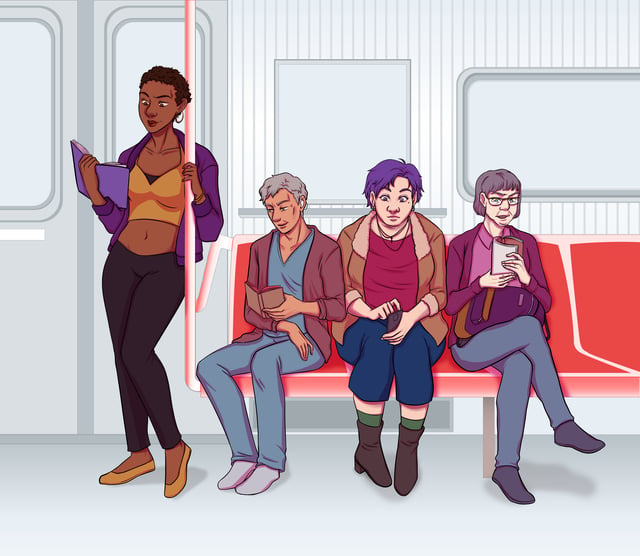Today we'll be talking about how comics are made and how we read them. Hint: the writers and artists think about the reader the entire time they're making the comic.
Need a refresher? Take a look at the intro post and the terminology post from last week.
Part 2: Comics Creation and Consumption
In this post, we’re going to quickly go through the creation process for the average comic and then talk a little about reading them. The two are closely tied, and for good reason.
How to Make a Comic - The Abbreviated and Simplified Version
To make a comic, you need someone capable of the following tasks: writing, drawing, coloring, and lettering. Sometimes it’s 4 or 5 people. Sometimes one person does it all. For this example, I’m going to use HEAVY VINYL, a series from Boom! (The series was originally called Hi-Fi Fight Club.) The issue I’m holding was built by a 5 person team, plus a designer and editors.
Here are the credits:
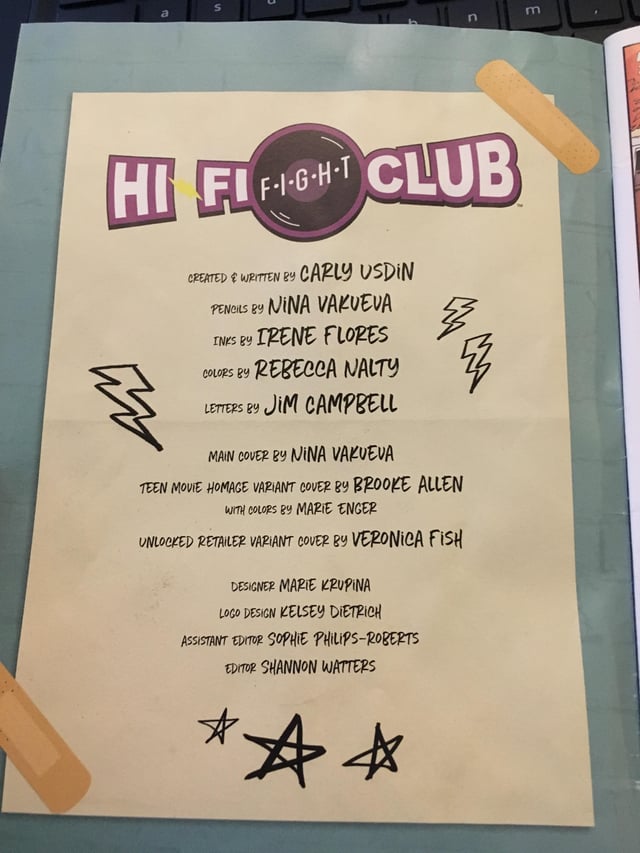
Let’s start at the top. “Created and Written by Carly Usdin.” This means that Carly came up with the series idea and wrote the script for the issue. Scripts vary from book to book and team to team. Some writers give the artist a page-by-page story, while others detail each individual “shot,” like a film director. It can be fun to read the back pages of a trade because sometimes you’ll get a few pages of script to look at.
“Pencils by Nina Vakueva.” Nina is the primary artist on this comic. She does the equivalent of story-boarding and designs the characters. Her art is the foundation of what the next two artists contribute.
“Inks by Irene Flores.” Irene takes the penciled pages from Nina and adds those lovely black lines and washes of shadow that give the images structure. Inking is a really interesting process and I could spend days watching artists like Jen Bartel.
“Colors by Rebecca Nalty.” Colorists, like inkers and letterers, do not get enough credit. The colors set the tone for a comic and individual scenes within, and can make or break a comic. Not every comic has a colorist, since many are in black and white. In those cases, ink washing contributes the shading.
“Letters by Jim Campbell.” The letterer makes all those fabulous speech bubbles and descriptive text boxes. They make sure all the words fit, look great, and flow with the narrative. The letterer helps you to know who is talking and when, which can be tricky if a panel contains multiple people.
If you look down the rest of the page, you can see a whole bunch of other people who have a hand in the making and promotion of the comic, whether directly or indirectly for Image. A lot of comics, especially webcomics, are a one-person endeavor. This means that one person is doing all of those jobs. Be patient with your weekly updates, readers.
Reading Comics
Alright, that’s who makes a comic. Now, how do you read them?
This is a Big Subject. I’m not going to be able to give you an in-depth guide here without turning it into a book. Thankfully, lots of people have already written the book(s)! Scott McCloud’s are the most frequently recommended, so I’ll go ahead and give you the links here.
Understanding Comics: The Invisible Art - A guide for readers and creators alike. It’s a comic that explains comics.
Making Comics: Storytelling Secrets of Comics, Manga, and Graphic Novels - Like the above, but geared toward creators.
Reinventing Comics: The Evolution of an Art Form - The title pretty much says it. McCloud talks about how comics are changing and where they're heading.
Here’s a quick rundown for new readers:
Reading the Art
Comics engage readers in a different way than prose. Comics can't tell you in words what the characters are smelling or feeling, for example. You might see a few scent lines drifting up from a pie and toward a character or you might see a panel that shows you fingers clutched around a piece of cloth. In either case, your mind draws the connection. Writers and artists work together to give you just enough information, without bogging down the narrative with text boxes and clunky speech.
Facial expressions and close-ups
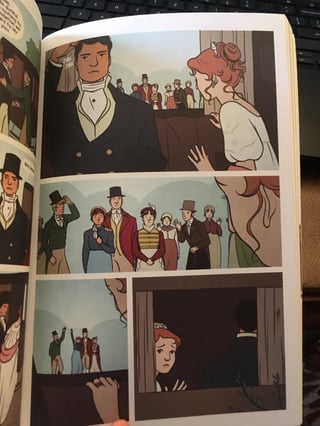
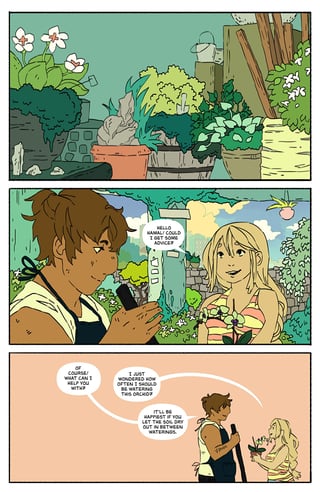
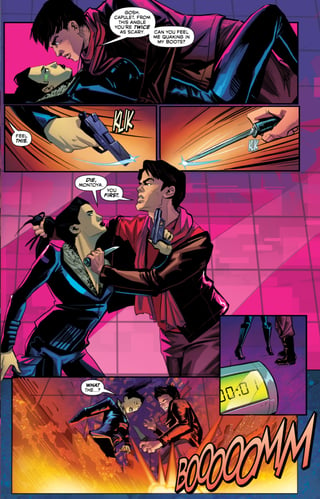
Pay attention to pagination - the creators do.
Pagination, or the layout of the comic, controls what you see and when. Big reveals are after a page-turn. The explosion might be in the middle of the book, composed of panels on each side. The kiss might get an entire page. When the creators dedicate a page-turn or an entire splash page to a scene, it's a signal to the reader that what you're seeing is important. Take this splash page from SPELLBOUND. You can probably guess that this is a Big Deal in the story.
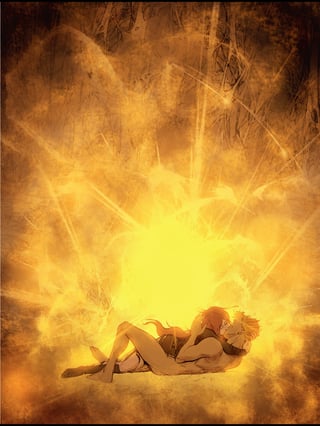
What’s Not Said is Just as Important as What Is
Comics have to walk the line between not-enough-info and just-enough-secrets. I don't often re-read novels, but I will go back through a comic a few times to pick up on details I missed the first time. Like a mystery novel, you'll often see things in the background on a second read that, with hindsight, are very clearly foreshadowing future events.
Comics like SEX CRIMINALS have backgrounds full of jokes and references, like a memorable issue that takes place in a sex shop. I'm not going to give you a screen shot here in an attempt to keep this post relatively SFW, but if you'd like to read a whole bunch of dirty jokes, that's the comic for you.
Next week, we're going to talk about how to manage your budget while reading all these fabulous comics!
Coming Up...
Part 3: How Not to Go Broke Reading Comics
Comics are expensive! We’ll walk you through some ways to manage your reading on a budget and still support the creators you love.
Part 4: Starter Comics
A highly subjective listing of some comics, publishers, and artists to start with.
Part 5: Your Local Comic Shop
Learning to love your LCS, avoid the haters, and order comics.
Part 6: What Are All These New Distribution and Funding Channels?
Kickstarter, Patreon, Gumroad, and ComiXology Unlimited. How to navigate new-ish channels of distribution and funding.
Part 7: Dirty Comics
A guide to comics for the 18+ crowd, with an emphasis on sex-positive, LGBTQ+ and female-friendly content.
Part 8: Comics for Kids
AKA, what to buy your niece/nephew/child/local library to get kids reading.
If you have any questions, please feel free to send them to suzanne@loveinpanels.com. I’ll gather questions as we go and answer them at the end if they aren’t covered in a post. Happy reading!

